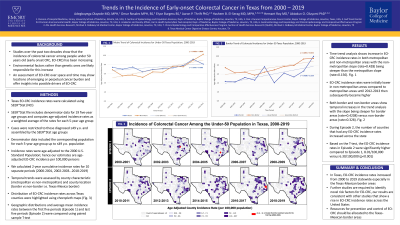Monday Poster Session
Category: Colon
P1928 - Trends in the Incidence of Early-Onset Colorectal Cancer in Texas from 2000–2019
Monday, October 28, 2024
10:30 AM - 4:00 PM ET
Location: Exhibit Hall E

Has Audio

Adegboyega Olayode, MD, MPH
Emory University School of Medicine
Atlanta, GA
Presenting Author(s)
Adegboyega Olayode, MD, MPH1, Omar Rosales, BS, MPH2, Elyse Burgess, BS2, Aaron Thrift, PhD2, Hashem El-Serag, MD, MPH2, Hemant Roy, MD2, Abiodun Oluyomi, PhD2
1Emory University School of Medicine, Atlanta, GA; 2Baylor College of Medicine, Houston, TX
Introduction: Although colorectal cancer (CRC) is prevalent among older people, studies over the past two decades show that its incidence among people under 50 years old (early onset CRC, EO-CRC) has been increasing. The reasons for this increase are not fully understood, though environmental factors rather than genetic ones are likely responsible. An assessment of EO-CRC over space and time may show locations of emerging or perpetual cancer burden and offer insights into possible drivers of EO-CRC.
Methods: Texas EO-CRC incidence rates were calculated using SEER*Stat (NCI); the SEER*Stat file includes denominator data for 19 five-year age groups and computes age-adjusted incidence rates as a weighted average of the rates for each 5-year age group. For our analyses, cases were restricted to those diagnosed ≤49 y.o. and assembled by the SEER*Stat age groups. The denominator data included the corresponding population for each 5-year age group up to ≤49 y.o. population. Incidence rates were age-adjusted to the 2000 U.S. Standard Population; hence our estimates are age-adjusted EO-CRC incidence per 100,000 persons. We calculated 2-year cumulative incidence rates for 10 separate periods (2000-2001, 2002-2003…2018-2019). First, we assessed temporal trends by county characteristic (metropolitan vs non-metropolitan) and county location (border vs non-border i.e. Texas-Mexico border). Second, we highlighted the distribution of EO-CRC incidence rates across Texas counties using choropleth maps. Last, we compared the geographic distributions and average mean incidence rates (paired sample T-test) between the first five periods (Episode 1) and last five periods (Episode 2).
Results: The time trend analysis shows increases in EO-CRC incidence rates in both metropolitan and non-metropolitan areas with the non-metropolitan slope being steeper. EO-CRC incidence rates were initially lower in non-metropolitan areas compared to metropolitan areas until 2012-2013 then subsequently became higher. Similarly, both border and non-border areas show temporal increases in the trend analysis with the slope being steeper for border areas. During Episode 2, the number of counties that had any EO-CRC incidence rates increased across the state, the EO-CRC incidence rates were significantly higher compared to Episode 1, 8.01/100,000 versus 6.30/100,000 (p < 0.001).
Discussion: In Texas, EO-CRC incidence rates increased from 2000 - 2019 statewide especially in the Texas-Mexican border areas.

Disclosures:
Adegboyega Olayode, MD, MPH1, Omar Rosales, BS, MPH2, Elyse Burgess, BS2, Aaron Thrift, PhD2, Hashem El-Serag, MD, MPH2, Hemant Roy, MD2, Abiodun Oluyomi, PhD2. P1928 - Trends in the Incidence of Early-Onset Colorectal Cancer in Texas from 2000–2019, ACG 2024 Annual Scientific Meeting Abstracts. Philadelphia, PA: American College of Gastroenterology.
1Emory University School of Medicine, Atlanta, GA; 2Baylor College of Medicine, Houston, TX
Introduction: Although colorectal cancer (CRC) is prevalent among older people, studies over the past two decades show that its incidence among people under 50 years old (early onset CRC, EO-CRC) has been increasing. The reasons for this increase are not fully understood, though environmental factors rather than genetic ones are likely responsible. An assessment of EO-CRC over space and time may show locations of emerging or perpetual cancer burden and offer insights into possible drivers of EO-CRC.
Methods: Texas EO-CRC incidence rates were calculated using SEER*Stat (NCI); the SEER*Stat file includes denominator data for 19 five-year age groups and computes age-adjusted incidence rates as a weighted average of the rates for each 5-year age group. For our analyses, cases were restricted to those diagnosed ≤49 y.o. and assembled by the SEER*Stat age groups. The denominator data included the corresponding population for each 5-year age group up to ≤49 y.o. population. Incidence rates were age-adjusted to the 2000 U.S. Standard Population; hence our estimates are age-adjusted EO-CRC incidence per 100,000 persons. We calculated 2-year cumulative incidence rates for 10 separate periods (2000-2001, 2002-2003…2018-2019). First, we assessed temporal trends by county characteristic (metropolitan vs non-metropolitan) and county location (border vs non-border i.e. Texas-Mexico border). Second, we highlighted the distribution of EO-CRC incidence rates across Texas counties using choropleth maps. Last, we compared the geographic distributions and average mean incidence rates (paired sample T-test) between the first five periods (Episode 1) and last five periods (Episode 2).
Results: The time trend analysis shows increases in EO-CRC incidence rates in both metropolitan and non-metropolitan areas with the non-metropolitan slope being steeper. EO-CRC incidence rates were initially lower in non-metropolitan areas compared to metropolitan areas until 2012-2013 then subsequently became higher. Similarly, both border and non-border areas show temporal increases in the trend analysis with the slope being steeper for border areas. During Episode 2, the number of counties that had any EO-CRC incidence rates increased across the state, the EO-CRC incidence rates were significantly higher compared to Episode 1, 8.01/100,000 versus 6.30/100,000 (p < 0.001).
Discussion: In Texas, EO-CRC incidence rates increased from 2000 - 2019 statewide especially in the Texas-Mexican border areas.

Figure: Trends in the incidence of early-onset colorectal cancer in Texas from 2000 – 2019
Disclosures:
Adegboyega Olayode indicated no relevant financial relationships.
Omar Rosales indicated no relevant financial relationships.
Elyse Burgess indicated no relevant financial relationships.
Aaron Thrift indicated no relevant financial relationships.
Hashem El-Serag indicated no relevant financial relationships.
Hemant Roy indicated no relevant financial relationships.
Abiodun Oluyomi indicated no relevant financial relationships.
Adegboyega Olayode, MD, MPH1, Omar Rosales, BS, MPH2, Elyse Burgess, BS2, Aaron Thrift, PhD2, Hashem El-Serag, MD, MPH2, Hemant Roy, MD2, Abiodun Oluyomi, PhD2. P1928 - Trends in the Incidence of Early-Onset Colorectal Cancer in Texas from 2000–2019, ACG 2024 Annual Scientific Meeting Abstracts. Philadelphia, PA: American College of Gastroenterology.
